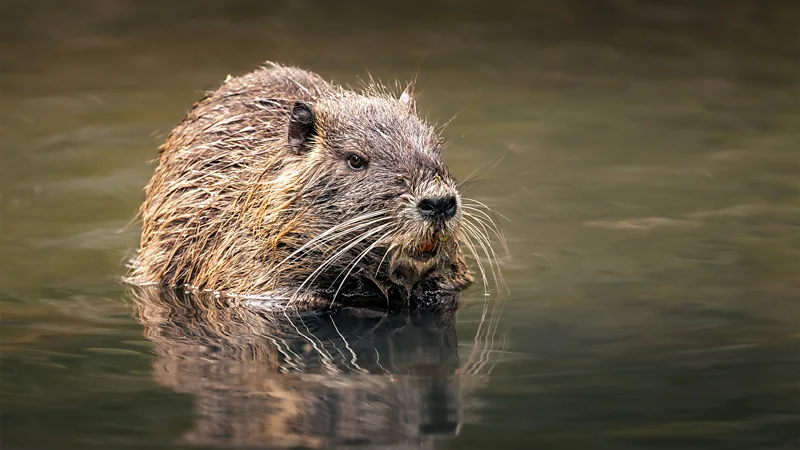How a Soviet swamp rat scheme for Azerbaijan went horribly wrong
A Soviet zoologist with a passion for long-extinct mammals set out to reinvigorate the landscape of the Caucuses in the 20th Century. Azerbaijan still bears the scars of his ambition today.

In the middle of the 20th Century, Russian zoologist Nikolai Vereshchagin set out on an ambitious mission across the mountainous landscape of Azerbaijan, and neighbouring Armenia and Georgia. He wanted to collect every possible record of the animals that had vanished from this region. Along Azerbaijan's Caspian Sea coast, cave paintings record an otherworldly savannah where humans hunted auroch bulls, gazelles and wild bezoar goats. Vereshchagin criss-crossed the Caucasus on his travels, finding endless signs of ongoing change and loss, including thousands of fossils and bone fragments from lost animals such as steppe mammoths and Turanian tigers.
In 1954, Vereshchagin used his finds to write a sweeping narrative charting the evolution of the Caucasus over more than 11,000 years; first amid a naturally warming climate and later due to "chaotic human activity", he wrote. His book, The Mammals of the Caucasus, was greeted by his Soviet superiors as a brilliant and "somewhat unusual book", not so much an authoritative history as a collage of fragmentary evidence, that linked up ancient paleontological data with recent stories of great game hunts led by deposed dukes and tsars.
Vereshchagin was a keen hunter, and once startled a conference audience with his own homemade "Palaeolithic" spear, tipped with an authentic point
To modern eyes, the book stands out for a very different reason. Its author was not just recording the region's ecological history, he was experimentally changing it. Vereshchagin sought to remake the ecosystems he documented, replacing the extinct creatures in the landscape with imported animals on a massive scale. His efforts left a mark on the region that can still be felt today, leaving Azerbaijan and its neighbours with thriving, stubborn populations of invasive species.
The decades following the 1930s were a time of audacious experimentation in the Soviet Union's wild spaces. Vereshchagin was part of the team that spearheaded efforts to reimagine these landscapes, providing animals to trap for fur and hunt for game. Vereshchagin was a keen hunter, and once startled a conference audience with his own homemade "Palaeolithic" spear, tipped with an authentic point. Beyond hunting, there was also a more nebulous goal of "enriching" local ecosystems.
Invasive species
Deliberately and accidentally, humans have introduced countless species of animals, plants and other organisms to non-native biomes. While most new additions are innocuous, more than 37,000 species have been found to harm native species, habitats and ecosystems, causing them to be labelled invasive, according to the United Nations' Intergovernmental Science-Policy Platform on Biodiversity and Ecosystem Services (IPBES).
Globally, invasive non-native species are one of the top five drivers of global biodiversity loss, according to IPBES, contributing to 60% of global extinctions and causing damages worth $423bn (£323bn) per year.
Experiments in so-called "acclimatisation" of animals from one country to another were prolific. In Azerbaijan, nine species of mammals were introduced, including short-tailed chinchillas from the Andes, raccoon dogs from China and Sika deer from Japan, as well as striped skunks, the famously pungent residents of North America.
Most of these species struggled to get a foothold in the varied and rugged landscape of Azerbaijan – but one species in particular thrived. Through the 1930s, Vereshchagin had personally supervised the introduction of an initial community of 213 giant South American rodents – known as coypu, nutria, swamp beavers, swamp rats or river rats – whose durable hides could be used to make fur hats and coat trims. Without realising, Vereshchagin and his team had proudly brought to the Caucasus an animal that would, by the 21st Century, be recognised as one of the world's 100 worst invasive species.
Today, 70 years on from publication of Vereshchagin's book, coypu can be found across almost every wetland in Azerbaijan, says ecological researcher Zulfu Farajli. When Farajli leads walking tours around the Gizilagaj State Reserve, a wetland reserve bordering the Caspian Sea, visitors are always interested in this hefty rodent with a long, naked, rat-like tail. "They always ask, 'What is this animal?'" says Farajli. Few expect to discover these shy rodents originate in the swamps of South America, nor to learn of their ability to sow destruction in their adopted surroundings.
In the past five years, Farajli's curiosity has grown into a campaign that aims to kickstart recognition of historical introductions of alien species and track the extent of the coypu's spread. He aims first to stimulate research on the coypu's impact, and answer some basic questions: just how many coypu are there in Azerbaijan? And how much damage – over the course of 90 years or so – have they really done?
A prolific rodent
Adult coypu are typically about two feet (60cm) in body length with a foot-long tail. Fully grown, each weighs as much or more than a Jack Russell terrier (7-9kg/15-20lb). Though similar in appearance to capybara – the world's largest rodent and beloved star of internet videos – coypu tend to have fewer adoring fans. Perhaps their most noticeable feature is their buck teeth: a pair of long, orange incisors that never stop growing.
Around the world, coypu dig burrows in riverbanks, destabilising them, accelerating erosion and increasing vulnerability to flooding. Coypu also forage aggressively, by some accounts eating 25% of their body weight each day, through winter and summer. Globally, their appetite has left areas of reed swamp and farmers' crops in tatters, impacting diverse plant, insect, fish and bird species. Additionally, coypus serve as a reservoir for diseases that can affect humans such as toxoplasmosis, an infection that is usually symptomless but can be harm pregnant women and people with weakened immune systems.
In their native range in the Argentinean Pampas and across the southern half of South America, they are found living in pairs or large colonies, on wetlands, lakes and riverbanks. Emerging to feast in the evening, these rodents graze voraciously on roots and swamp grasses, with studies showing they prefer aquatic plants as they are safer from predators around water. Coypu are capable swimmers, thanks to a pair of large, webbed feet on their hind legs, and are able to dive for up to five minutes to feed and escape from predators, including caiman, jaguar, mountain lion, ocelot and eagles.
The coypu's journey to becoming an invasive pest began with Spanish colonists in the 18th Century. Conquistadors sailing the Rio de la Plata, the river that divides Argentina and Uruguay, mistook it for otter and gave it the name "nutria", the Spanish word for "otter". The name "coypu" comes from the indigenous Mapuche word used in Chile and eastern Argentina. Under the Spanish, coypu hides began to be exported to Europe, mainly for hats and neck-warmers, and by the late 19th and early 20th centuries, live coypu were shipped to breed in fur farms in Europe and North America. The rodents readily adapted to domestication.
Today, coypu can be found on every continent except Antarctica and Oceania. Populations can quickly multiply. Female coypu typically give birth to four to five offspring in one litter, and can get pregnant just days later, allowing them to give birth two or three times each year. In many places, they are free to multiply without the natural predators they face in South America, although there are signs they have become enmeshed in local food chains: they are eaten by red fox and grey wolf in Italy, by golden jackals across the Balkans, and by a white-tailed eagle in Croatia. Humans have sometimes followed – in the 1960s coypu meat was reportedly sold in British restaurants disguised as "Argentine hare" and a Moscow burger restaurant has sold it in the past decade as a healthy meat (it is leaner than beef).
Untold numbers
Outside of Europe and North America, the coypu's spread has been less well-documented. The spread of coypu is believed to be widely underestimated and new arrivals mistaken for beaver, muskrat or other rodents. One study that analysed videos and photographs on YouTube and Flickr found coypu living unrecognised in Kenya, Iran and Lebanon, with major clusters in the Caucasus and in East Asia.
Throughout the world fur farm escapees are common, but the Caucasus history is slightly different. Farajli's research found that many coypu were acclimatised to their new surroundings in enclosed areas, before being released into open or "semi-wild" areas where they could once more be trapped. In many areas of the former Soviet Union, acclimatisation efforts were responding to a long history of trapping – capturing animals in traps, often for fur and meat – adds Sandro Bertolino, an animal ecologist at the University of Turin.
I don't remember any wetland I've been in and not really seen the tracks – Zulfu Farajli
By the time he wrote The Mammals of the Caucasus, Vereshchagin believed his task was only part-complete. One piece of unfinished business was the "planned extermination" of species he saw as undesirable, such as wolves and jackals, which hunted game and livestock. Coypu should be introduced much more widely, he believed, including semi-wild into new areas like the Lenkoran Lowlands, neighbouring the Gizilagaj State Reserve, on the edge of the Caspian Sea. In conjunction, he saw these efforts as a way to make the environment better suited to supporting human residents, at a time of rapid economic development in the Soviet Union.
No one knows if Vereshchagin ever got his wish for a mass release into the Lenkoran Lowlands or whether the coypu made their way there anyway, says Elshad Askerov, director of the World Wide Fund for Nature (WWF) in Azerbaijan. But by 1966, a report looked at whether there were "biotechnical measures", such as hunting their predators, that could help the species to spread, finding that many coypu were being eaten by predators such as wolves. Throughout the 20th Century, Soviet authorities supported hunting of these apex predators.
"One hundred rubles they gave for one killed wolf," says Askerov, adding the bulk of that fee was a reward for killing a pest. "At that time, my father's monthly salary was 120-140 rubles."
From the initial 213 coypu introduced to Azerbaijan by Vereshchagin, there might now be thousands, says Farajli – with populations spreading into Armenia and Georgia. "I don't remember any wetland I've been in and not really seen the tracks," says Farajli. The animal leaves behind it a characteristic trail made by two webbed hind feet bisected by a dragging tail.
Coypus' full population and range in Azerbaijan are key facts that would allow ecologists to understand its impact and how to respond, but there are no comprehensive estimates of either.
"Vereshchagin mentions that in five years their numbers boosted to 400-500 animals and they only released just over 200 animals. So they doubled in five years," says Farajli. "It's super-crazy for me how capable these animals were."
In Azerbaijan, the impacts of the coypu are felt in one of the world's biodiversity hotspots. The Caucasus region sits at a "biogeographic crossroads" where the flora and fauna of Europe meets Central Asia and the Anatolian peninsula, earning recognition from Conservation International as one of the 25 most biologically rich and most endangered terrestrial ecosystems in the world.
Farajli became aware of their impact in Gizilagaj State Reserve on the Caspian Sea coast. A Ramsar wetland of global importance designated for the protection of birds, the reserve is an especially important area for migration and wintering, supporting endangered species such as the white headed duck, ferruginous duck and marbled teal. In recent years it has been a resting place for the final Siberian Crane in a western population that has declined to hunting and the degradation of wetlands on its 5,000km (3,100-mile) migratory route between the Arctic and Iran.
An experiment led by Bertolino in central Italy showed that coypu posed an extra risk to birds by crushing eggs when they clumsily sit down for a rest in nests. As a bird watcher, Farajli says he wants to see more research about the interactions between coypu and Azerbaijan's birdlife. "During the bird watching trips or tours, we always see them in the exact same habitats where we see wetland birds," he says.
Even without new research to understand their impact on sites like this, we have the knowledge from experiments abroad, like Bertolino's, to make sound decisions, Askeov and Farajli believe, including that populations should be managed in protected areas like Gizilagaj State Reserve.
The bounty problem
Few countries have managed to fully eradicate coypu. The UK, however, is the "classic example" of a country that succeeded, says Bertolino.
Having been imported in the 1920s, coypu reached an estimated 200,000 animals in the early 1960s. After a coordinated hunting and trapping effort, the UK Department of Agriculture's Coypu Research Lab trapped the final wild coypu in Britain in 1989. But such comprehensive removal is much more challenging in countries where numbers have grown very large, resources are scarce, and new coypu can reenter across national borders.
Many countries and US states instead focus on managing coypu populations to minimise harmful impacts. "It is heavily controlled in some [states] on the south-east coast – Louisiana, for example," says Bertolino. In Louisiana, where millions of coypu roam free, the state pays bounties of $6 (£4.60) or more for each of the copyu's rat-like tails delivered, averaging more than 200,000 each breeding season. The approach has been credited with reducing the amount of healthy marsh being converted into open water.
In Azerbaijan, WWF's Askerov advocates a similar approach, bringing back some of the Soviet-era bounties but for invasive pests rather than native predators. But such programmes come with risks, warns Friederike Gethöffer, wildlife biologist at University of Veterinary Medicine Hannover in Germany. Bounties often improve hunting rates, she says. "Nevertheless, they are discussed controversially, because they might also create a market and result in a management that does not aim at eradication," she says.
Bounties attract hunters to areas where there are high density populations of target species, where they can gun down many in a day, says Bertolino. This can thin out large populations but rarely removes them from a location completely. "When the trapping or shooting becomes less profitable, you move to another area and then to another area because you want to maximise your income," he says. In contrast, effective management as in the UK continues once the population has started to decrease. "Otherwise, you simply remove some animals but then the next year reproduction can compensate," he says.
In Azerbaijan, Farajli says the most important thing is overturning the current fee systems that means hunters must pay if they shoot a coypu. Since 2004, Azerbaijan's Cabinet of Ministers has charged 1,65 AZN (about $1) for each nutria tail, and may also fine hunters an additional 22 AZN ($13/£10) for "damage to nature" for illegal hunting. These payments exceed those for hunting some protected species listed in Azerbaijan's Red Book of endangered species, Farajli notes. (The Government of Azerbaijan did not respond to a request for comment.)
But the first step, Farajli says, is for local people to know more about the coypu's story. Nine decades after their first releases, coypu exists today in wetlands near Gizilagaj State Reserve. Local shepherds and fishermen see the animals every day and pay little attention, Farajli says. "It's not dangerous, it's not affecting their lives," he says. "So they don't really care."
Farajli wants to see that change. Some nine decades after the acclimatisation strategies got underway, the animals at risk are those like the Siberian crane, whose last individual, named Omid ("hope" in Persian) was not seen in Azerbaijan last year. On every tour Farajli sees this ecosystem and how important it is for rare birds. "And then one guy or a group of guys decides: 'Let's bring another completely new animal to the environment', and destroys everything, in a sense," he says.
Despite Vereshchagin and his colleagues' belief that they were replenishing the Caucasus' fauna, it seems evident now that invasives like coypu are depleting it.
-BBC







